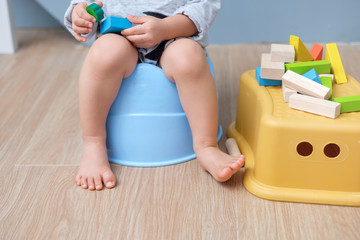Tips for Successful Potty Training
by Bailey Boss, Occupational Therapy Student
Potty training is a major milestone for kids and parents alike. Just like other daily skills, children with and without disabilities need to practice to learn how to properly engage in toileting. Independence in toileting requires that the child be able to get on and off the toilet, manage fasteners and clothing, clean after toileting, and wash and dry hands efficiently, without supervision. Many parents often ask us when it is appropriate to begin potty training and what advice can we give to encourage potty training success. Most children express behaviors of readiness between 18 months and 3 years, with girls initiating signs of readiness before boys.
Independence in toileting is dependent on the child’s physical, developmental, and behavioral milestones. It is important to note that many times, behaviors that are seen with potty training are a result of potty training starting too soon. Thus, the key to success is to be patient and let your child’s motivation lead the process. Here are tips for establishing and prompting successful toileting routines for children:
- Identify when the child is ready to toilet train. Signs of readiness can include interest in visiting the bathroom, pretending to use toilet paper and flushing, wanting to observe others using the bathroom, reporting to caregiver they have wet or soiled their diaper, and getting upset when diaper is soiled.
- Spell out expectations in the beginning
- Dedicate a bathroom to toilet training
- Change layout of objects or accessibility of bathroom environment – keep toilet paper within easy reach, use fun-smelling soaps and brightly-colored towels to make handwashing fun, and label the faucets with colors to indicate which is cold and which is hot to prevent water burns
- Provide a way to indicate a need to go (e.g. spoken, physical, pictures or gestural cues)
- Use simple, positive terms to talk about the toilet
- Use a wet-dry chart to determine typical times for toileting and use same routine and rituals (e.g. before car trips, before events, after meals, before bedtime, once you wake up)
- Make a visual schedule for toileting steps and place it on the walls for the child to reference
- Have the child dress in easy-to-manipulate clothing at first. Avoid snap, buttons, and overalls when potty training.
- Support the child’s body on the toilet – potty chair, potty ring, and foot rest
- If child does not sit on the toilet long enough, use a timer and instruct “stay seated until timer goes off”
- If your child uses too much toilet paper, place duct tape on the wall to mark how much paper to roll out.
- If child is fearful, have him or her open bathroom door for escape, then flush
- Be patient – read a favorite book, sign a song, or run water when the child is sitting on the toilet
- Encourage positive behavior with lots of praise and rewarding them for their participation
- For boys, it’s often best to master urination sitting down, and then move to standing up after bowel training is complete. Next, use painters tape to make a line for boys to know where to stand and offer toilet target or use goldfish/fruit loops to help them aim in the toilet.
- For a sensory seeker: use bright lights, fun music, and toys alerting aromatherapy (peppermint and eucalyptus)
- For sensory avoiders: use soft lighting, soft music, and calming aromatherapy (lavender and chamomile)
- If your child does not seem to notice when their diaper is dirty you may choose to place underwear underneath the diaper to provide more discomfort and increase the feeling of being wet or soiled while decreasing the mess.
- If your child resists using the potty chair or toilet or isn’t getting the hang of it within a few weeks, take a break. Chances are he or she isn’t ready yet.







